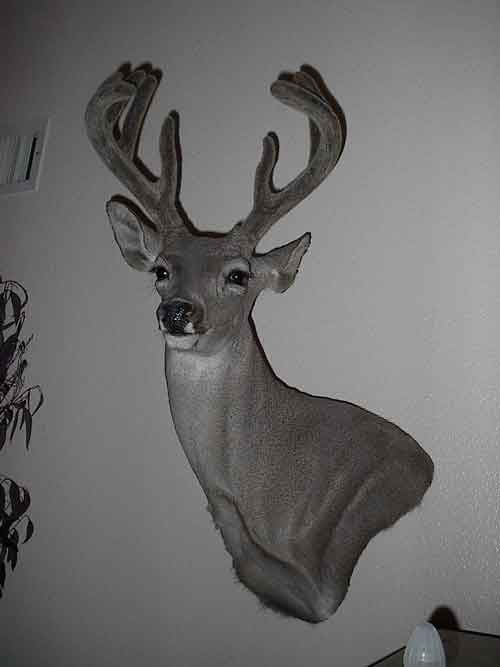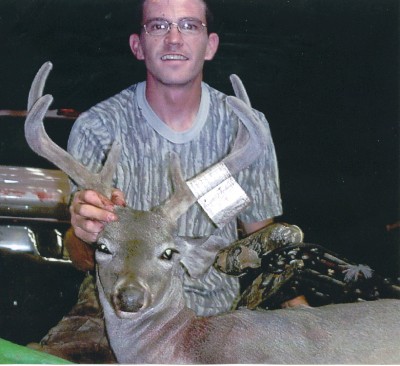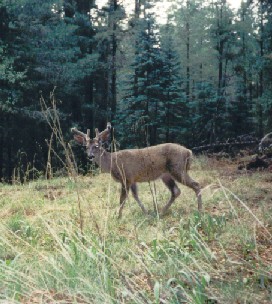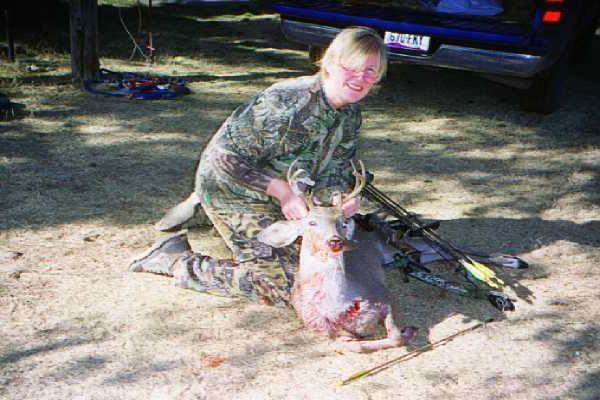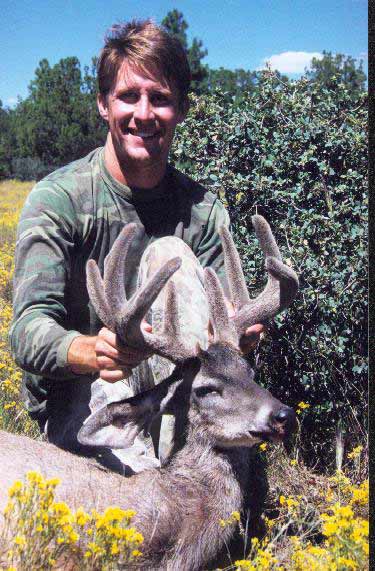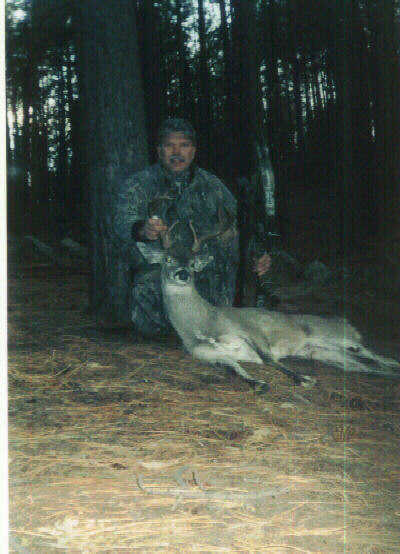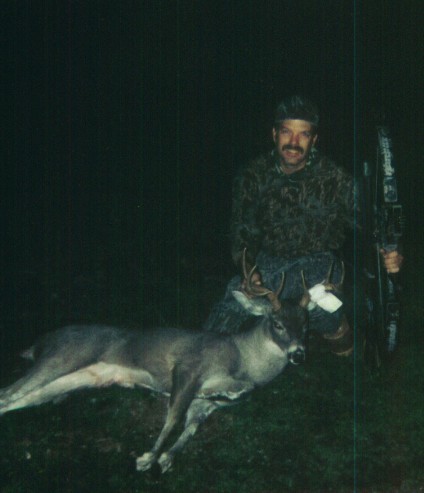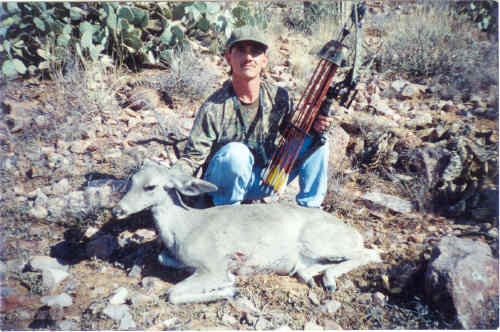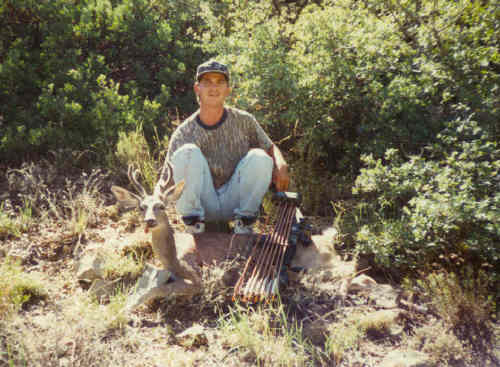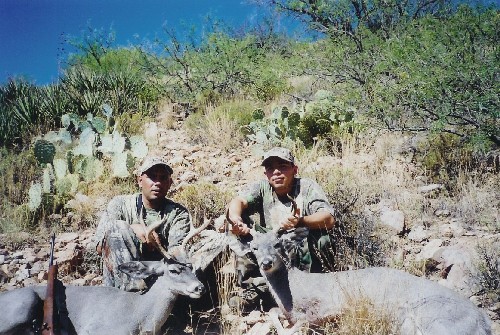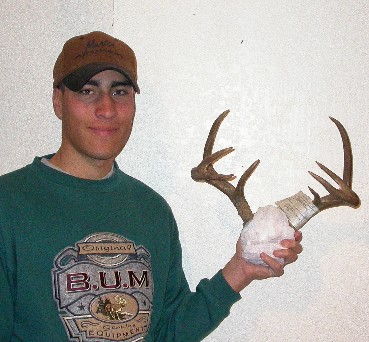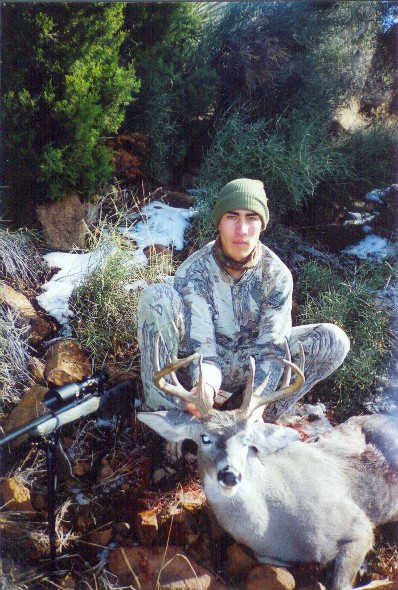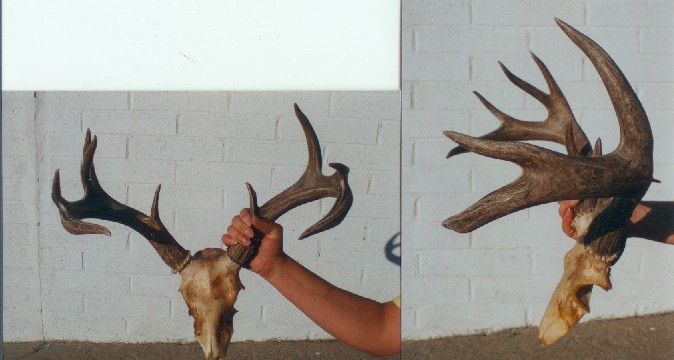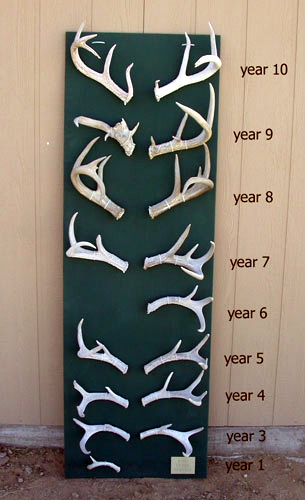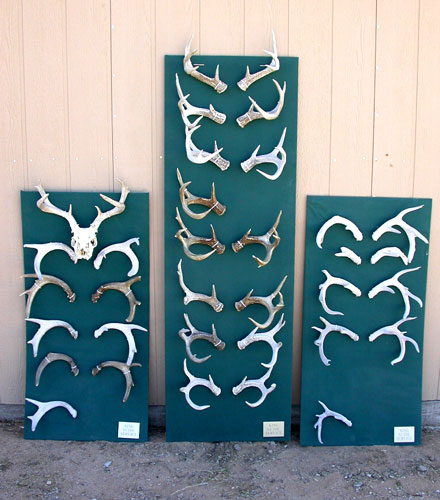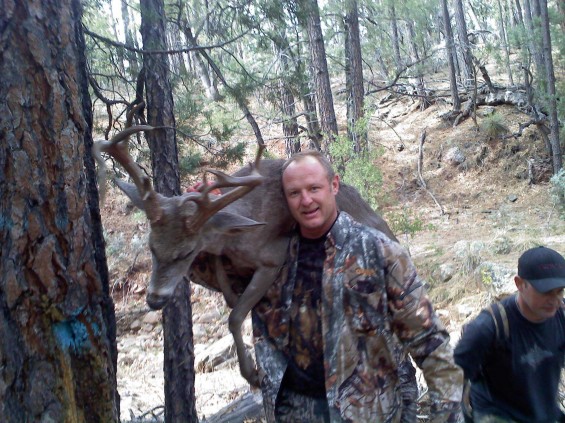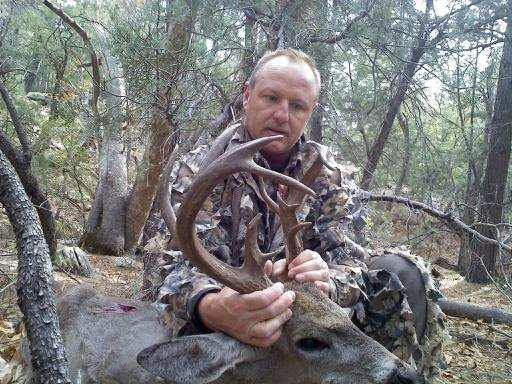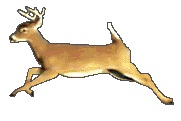Posts
Bruce Bingham 1999
Jan. 1999
Unit 29, Arizona
This buck was chasing a doe around an oak flat and Brian was able to get a thirty yard shot. He used a 100 grain glue-on four-blade Muzzy broadhead to put him down in about fifty yards. No ground shrinkage here, official Bow Hunting in Arizona score, 111 5/8 net. If the G3 on the right antler had not been broken he would have netted over 115. Great buck!!
Bruce’s son Dane is with him in the second photo. This is Bruce’s third state recordbook buck he has taken with a bow!
Gary Baldwin 2000
Aug. 2000
Southern AZ
This deer was taken in 2000 during the early archery season in southern AZ. Gary watched this deer and several others for 2 months and actually missed a 30 yard shot on opening day due to pouring rain and low visibility (water in his peep sight). He harvested him several days later after a 300 yard stalk and a 42 yard shot. His equipment consisted of a 75lb Darton Maverick, ACC 3-60, and a Snyper broadhead.
This buck has a Pope & Young Official score of 107 5/8 gross and 104 net.
Brian Fish 2003
Jan. 2003
Southeastern, AZ
The buck was taken at 50yds after a 15 minute stalk. (15 minutes!!)
Brian saw the buck following a doe about 100 yards away as Brian walked to his treestand, which he had on a scrape line. So instead of getting in the treestand, he started stalking the buck. The country was fairly thick at an elevation of 8400ft. The buck was so engrossed with the doe that it was fairly easy to stalk him. When Brian got to 50yds the buck and doe started to head into a big thick canyon, so he figured that was the time to take him. The shot was true.
The buck is a 4×4 including eyeguards. It scores 92 inches gross, 88 1/2 inches net unofficially.
Robert Andresen 2002
Sept. 2002
Unit 31, Arizona
Robert shot this buck at 22 yards. It is 17 1/2 inches wide and 14 inches tall. It nets 92 7/8. Nice buck!
The lower picture is the same buck earlier in the summer.
Coues Deer Celebration 5 – 2007-2008
This video is the longest yet. It’s about 10 minutes long and has over 220 photos in it. You will see bucks of all kinds…..giant bucks, tiny bucks and lots in between. Photos and video are from the website during 2007-08 season.
Coues Celebration 4 video
This video is a collection of about 105 deer and other photos that CouesWhitetail.com members have sent in during the past 06-07 season. It has giant bucks and not-so-giant bucks, but it’s great to get your blood flowing! See if you or your hunting partners are in it! I output this as a high quality file, which means it’s much larger than the other three versions of Coues Deer Celebration videos.
June Arnold 2003
Jan. 2003
Unit 35A, Arizona
June shot this buck at 31 yards with her PSE Carrera with 100 grain Muzzy broadheads. It was about 1 pm when she snuck up on this young Coues buck that was bedded between two manzanitas in tall grass. She only had a front shot and took it, with the arrow going through the front of his chest and hitting part of his heart. He didn’t go far and she got a fine deer.
Josh Epperson 1999
Josh Epperson
September 1999
Josh shot this buck at 12 yards from a stand over a salt lick. The buck gross scores 102 0/8. Net 96 inches after deducting for velvet.
Mark Hanson 2003
January 2003
Gila County, AZ
Another fine archery deer taken in the Ponderosa Pine! Mark took this buck with a 40 yard shot at 10 in the morning from a tree stand. He used a PSE Carrera, with Limb Savers, a Trophy Taker arrow rest and Winners Choice Bowstring. He used ACC 3-49 arrows with 100 gr. Rocket “steelhead” broadheads.
Mark Hanson 1994
Read about Mark’s hunt in the “hunt stories” section!
This bucks grossed 90 1/8 Pope and Young.
Dan Avendano 1995
Jan. 1995
Unit 37b, Arizona
Coues deer doe taken with a 60 yard shot. Dan also shot a javelina on the same day!
Dan Avendano 1994
August 1994
Unit 24b, Arizona
This 3×2 buck still in velvet was taken with a 20 yard shot.
Rueben and Javier Campos
Oct. 2002
Unit 32, Arizona
Two nice bucks from the Galiuro Mtns. The tall one on the left looks like it has no eyeguards, which is unusual in Coues. Both are nice looking Coues.
John Branch December 2002
Unit 23, Arizona
John killed this nice 4×4 with one shot from 320 yards. He hunted every weekend of the season and passed on numerous smaller bucks. I hunted quite a bit with John during the season and this is a really nice buck. It is a very large bodied deer and had quite a bit a fat on it, which is remarkable considering the many drought years we have been having.
**update – I knew this buck was big bodied, but I just found out that it probably weighed 115-120 lbs. whole. At the meat locker it weighed 79 lbs. and it had no head, legs, internal organs or skin on it!
Martin Guarena 2002
Martin Guerena December 2002
Unit 24A, Arizona
This 4×4 buck green scored 90 2/8 net typical. 1st circum.: 3 2/8 on both sides; main beams: 15 2/8 rt, 14 7/8 lft; inside spread: 12 0/8
Check out those long second points! Martin hunted hard this season, passing on many smaller bucks. Can you believe he got drawn for December Unit 24A two years in a row!!!! Lucky guy.
Guarena 24A
Martin Guerena, December 2001
Unit 24A, Arizona
This 5×5 buck officially nets 107 4/8 points (non-typical B&C). Main beams: 17 0/8; 16 0/8 1st circumference measurement: 4 1/8 on both sides Inside spread: 14 3/8 Abnormal points: 3 points totaling 13 7/8 inches
Check out the 2nd tine on the left antler – It’s hard to see because it blends into Martin’s arm.
Mark Clark December 1998
Gila County, Arizona
This 5×4 buck officially nets 109 0/8 (nontypical B&C)
main beams: 17 1/8; 16 7/8
inside spread: 15 3/8
1st circumference 4 6/8 on both beams
Arizona Game and Fish Department Hunter Education Classes
Arizona Game and Fish offers Hunter Education classes throughout the year. For the latest information, please visit their website.
Arizona Hunt Unit Maps
These maps are provided courtesy of the Arizona Game and Fish Department. They are published annually in the hunting regulations. These maps were scanned from the 2002-2003 Arizona hunt regulations. Feel free to download these images if you would like.
You can use these maps along with the draw odds and hunt stats that I have also posted to help you determine where you want to hunt.
PICS
Overview of entire state.
Units 1-4 and 27. Area covered is north of the Mogollon rim around Holbrook and down to Clifton.
Units 5-9, 12-13. North of Grand Canyon and Flagstaff area.
Units 10, 15-20. Kingman and Prescott areas.
Units 16B, 20C, 39, 40, 42-46. Parker, Yuma, Gila Bend areas.
Units 28-37. Tucson, Chiricahua Mtns, Dragoon Mtns., Galiuro Mtns. , Ft Huachuca.
Units 20B- 24, 39 and 42. Phoenix, Payson, Roosevelt, Globe, Winkelman.
Classification data for Coues Whitetail in Arizona
This table provides survey data for Coues deer in Arizona by unit and by year. Years covered are 1997-2001. Not all units were surveyed every year. Also, please note that this is what is usually referred to as “classification data”, meaning that these are counts of deer that were seen by wildlife managers during their surveys. These numbers do NOT represent the total number of deer in these units. Managers gather classification data to look at changes over time of buck:doe and fawn:doe ratios. These numbers are used to evaluate the herds. High buck:doe ratios usually occur in lightly hunted populations, whereas areas that are heavily hunted will have much lower buck:doe ratios. Fawn:doe ratios are used as a measure of the productivity of the herd. Ratios are most accurate when many deer are classified. So look at the total number of deer classified to see how valid the ratios might be. For example, in unit 1 in 2001 only 14 deer were seen. I wouldn’t put a lot of confidence in that classification data to be representative of the entire unit. Whereas in unit 36A in 2001, 347 deer were counted, which should give you more confidence in the ratios. The numbers in the “unclassified” column represent deer that were seen but could not be classified for sure as a buck, doe, or fawn. This might happen if a manager just saw the tail end of a deer disappearing into thick brush as they conducted the survey.
Data has been gleaned from the Arizona Game and Fish publication “Hunt Arizona – 2002 edition”.
| Unit | Year | Bucks | Does | Fawns | UC | Total | Bucks/ 100 does | Fawns/100 does |
| 1 | 2001 | 2 | 7 | 5 | 0 | 14 | 29 | 71 |
| 4 | 2001 | 1 | 12 | 2 | 0 | 15 | 8 | 17 |
| 5 | 1997 | 0 | 1 | 0 | 0 | 1 | 0 | 0 |
| 5 | 1998 | 0 | 2 | 0 | 0 | 2 | 0 | 0 |
| 5 | 2000 | 1 | 0 | 0 | 0 | 1 | ||
| 6A | 1997 | 9 | 38 | 8 | 0 | 55 | 24 | 21 |
| 6A | 1998 | 9 | 27 | 5 | 0 | 41 | 33 | 19 |
| 6A | 1999 | 6 | 25 | 18 | 0 | 49 | 24 | 72 |
| 6A | 2000- | 8 | 17 | 6 | 0 | 31 | 47 | 35 |
| 6A | 2001 | 3 | 20 | 2 | 0 | 25 | 15 | 10 |
| 6B | 1997 | 3 | 6 | 1 | 2 | 12 | 50 | 17 |
| 6B | 1998 | 4 | 13 | 2 | 0 | 19 | 31 | 15 |
| 6B | 1999 | 6 | 8 | 3 | 0 | 17 | 75 | 38 |
| 6B | 2000 | 6 | 11 | 0 | 0 | 17 | 55 | 0 |
| 6B | 2001 | 4 | 21 | 3 | 0 | 28 | 19 | 14 |
| 8 | 1997 | 1 | 16 | 5 | 0 | 22 | 6 | 31 |
| 8 | 1998 | 3 | 16 | 4 | 0 | 23 | 19 | 25 |
| 8 | 1999 | 2 | 20 | 0 | 0 | 22 | 10 | 0 |
| 8 | 2000 | 1 | 8 | 0 | 0 | 9 | 13 | 0 |
| 8 | 2001 | 4 | 14 | 4 | 1 | 23 | 29 | 29 |
| 19A | 2001 | 6 | 10 | 2 | 0 | 18 | 60 | 20 |
| 21 | 1997 | 14 | 48 | 2 | 0 | 64 | 29 | 4 |
| 21 | 1998 | 21 | 47 | 18 | 0 | 86 | 45 | 38 |
| 21 | 1999 | 15 | 55 | 11 | 0 | 81 | 27 | 20 |
| 21 | 2000 | 12 | 20 | 3 | 0 | 35 | 60 | 15 |
| 21 | 2001 | 14 | 41 | 12 | 2 | 69 | 34 | 29 |
| 22 | 1997 | 29 | 115 | 21 | 0 | 165 | 25 | 18 |
| 22 | 1998 | 28 | 108 | 30 | 0 | 155 | 26 | 28 |
| 22 | 1999 | 25 | 89 | 47 | 0 | 161 | 28 | 53 |
| 22 | 2000 | 23 | 83 | 24 | 0 | 130 | 28 | 29 |
| 22 | 2001 | 37 | 95 | 23 | 1 | 156 | 39 | 24 |
| 23 | 1997 | 27 | 133 | 16 | 0 | 176 | 20 | 12 |
| 23 | 1998 | 16 | 65 | 25 | 0 | 106 | 25 | 38 |
| 23 | 1999 | 17 | 72 | 33 | 0 | 122 | 24 | 46 |
| 23 | 2000 | 18 | 98 | 9 | 0 | 125 | 18 | 9 |
| 23 | 2001 | 21 | 88 | 29 | 0 | 138 | 24 | 33 |
| 24A | 1997 | 17 | 89 | 20 | 3 | 129 | 19 | 22 |
| 24A | 1998 | 15 | 54 | 20 | 0 | 89 | 28 | 37 |
| 24A | 1999 | 18 | 80 | 26 | 0 | 124 | 23 | 33 |
| 24A | 2000 | 16 | 70 | 16 | 0 | 102 | 23 | 23 |
| 24A | 2001 | 12 | 52 | 12 | 3 | 79 | 23 | 23 |
| 24B | 1997 | 4 | 57 | 19 | 1 | 81 | 7 | 33 |
| 24B | 1998 | 22 | 97 | 30 | 0 | 149 | 23 | 31 |
| 24B | 1999 | 11 | 43 | 21 | 1 | 76 | 26 | 49 |
| 24B | 2000 | 12 | 64 | 16 | 0 | 92 | 19 | 25 |
| 24B | 2001 | 9 | 48 | 26 | 0 | 83 | 19 | 54 |
| 27 | 1997 | 13 | 41 | 10 | 1 | 65 | 32 | 24 |
| 27 | 1998 | 13 | 59 | 20 | 0 | 92 | 22 | 34 |
| 27 | 1999 | 28 | 100 | 30 | 0 | 158 | 28 | 30 |
| 27 | 2000 | 24 | 98 | 31 | 0 | 153 | 24 | 32 |
| 27 | 2001 | 17 | 46 | 9 | 0 | 72 | 37 | 20 |
| 28 | 2000 | 3 | 3 | 0 | 0 | 6 | 100 | 0 |
| Unit | Year | Bucks | Does | Fawns | UC | Total | Bucks/ 100 does | Fawns/100 does |
| 29 | 1997 | 27 | 135 | 32 | 8 | 202 | 20 | 24 |
| 29 | 1998 | 25 | 102 | 28 | 0 | 155 | 25 | 27 |
| 29 | 1999 | 16 | 92 | 28 | 3 | 139 | 17 | 30 |
| 29 | 2000 | 14 | 99 | 33 | 2 | 148 | 14 | 33 |
| 29 | 2001 | 19 | 98 | 30 | 2 | 149 | 19 | 31 |
| 30A | 1997 | 25 | 116 | 40 | 0 | 181 | 22 | 34 |
| 30A | 1998 | 21 | 88 | 30 | 0 | 139 | 24 | 34 |
| 30A | 1999 | 12 | 93 | 38 | 0 | 143 | 13 | 41 |
| 30A | 2000 | 19 | 77 | 23 | 1 | 120 | 25 | 30 |
| 30A | 2001 | 11 | 87 | 28 | 1 | 127 | 13 | 32 |
| 30B | 1997 | 20 | 94 | 33 | 0 | 147 | 21 | 35 |
| 30B | 1998 | 37 | 95 | 41 | 1 | 174 | 39 | 43 |
| 30B | 1999 | 12 | 51 | 30 | 0 | 93 | 24 | 59 |
| 30B | 2000 | 13 | 54 | 34 | 0 | 101 | 24 | 63 |
| 30B | 2001 | 28 | 77 | 33 | 1 | 139 | 36 | 43 |
| 31 | 1997 | 32 | 112 | 22 | 3 | 169 | 29 | 20 |
| 31 | 1998 | 20 | 95 | 26 | 3 | 144 | 21 | 27 |
| 31 | 1999 | 21 | 82 | 21 | 0 | 124 | 26 | 26 |
| 31 | 2000 | 24 | 84 | 12 | 2 | 122 | 29 | 14 |
| 31 | 2001 | 29 | 129 | 42 | 7 | 207 | 22 | 33 |
| 32 | 1997 | 38 | 164 | 42 | 3 | 247 | 23 | 26 |
| 32 | 1998 | 29 | 126 | 43 | 8 | 206 | 23 | 34 |
| 32 | 1999 | 34 | 126 | 33 | 1 | 194 | 27 | 26 |
| 32 | 2000 | 47 | 122 | 39 | 4 | 212 | 39 | 32 |
| 32 | 2001 | 34 | 132 | 40 | 2 | 208 | 26 | 30 |
| 33 | 1997 | 33 | 129 | 47 | 6 | 215 | 26 | 36 |
| 33 | 1998 | 31 | 98 | 53 | 2 | 184 | 32 | 54 |
| 33 | 1999 | 37 | 104 | 36 | 1 | 178 | 36 | 35 |
| 33 | 2000 | 29 | 132 | 50 | 1 | 212 | 22 | 38 |
| 33 | 2001 | 30 | 139 | 48 | 0 | 217 | 22 | 35 |
| 34 | 2000 | 0 | 3 | 1 | 0 | 4 | 0 | 33 |
| 34A | 1997 | 20 | 223 | 61 | 2 | 306 | 9 | 27 |
| 34A | 1998 | 31 | 211 | 82 | 11 | 335 | 15 | 39 |
| 34A | 1999 | 28 | 256 | 87 | 16 | 387 | 11 | 34 |
| 34A | 2000 | 29 | 189 | 57 | 38 | 313 | 15 | 30 |
| 34A | 2001 | 20 | 142 | 67 | 88 | 317 | 14 | 47 |
| 34B | 1997 | 18 | 138 | 20 | 0 | 176 | 13 | 14 |
| 34B | 1998 | 14 | 87 | 28 | 6 | 135 | 16 | 32 |
| 34B | 1999 | 11 | 59 | 20 | 1 | 91 | 19 | 34 |
| 34B | 2000 | 17 | 75 | 23 | 6 | 121 | 23 | 31 |
| 34B | 2001 | 20 | 82 | 42 | 10 | 154 | 24 | 51 |
| 35A | 1997 | 26 | 144 | 21 | 2 | 193 | 18 | 15 |
| 35A | 1998 | 21 | 79 | 23 | 0 | 123 | 27 | 29 |
| 35A | 1999 | 27 | 70 | 21 | 0 | 118 | 39 | 30 |
| 35A | 2000 | 24 | 92 | 29 | 3 | 148 | 26 | 32 |
| 35A | 2001 | 30 | 72 | 40 | 4 | 146 | 42 | 56 |
| 35B | 1997 | 19 | 153 | 29 | 3 | 204 | 12 | 19 |
| 35B | 1998 | 17 | 112 | 53 | 1 | 183 | 15 | 47 |
| 35B | 1999 | 11 | 63 | 27 | 3 | 104 | 17 | 43 |
| 35B | 2000 | 14 | 64 | 21 | 0 | 99 | 22 | 33 |
| 35B | 2001 | 30 | 85 | 44 | 6 | 165 | 35 | 52 |
| 36A | 1997 | 39 | 193 | 54 | 1 | 287 | 20 | 28 |
| 36A | 1998 | 30 | 155 | 61 | 10 | 267 | 18 | 37 |
| 36A | 1999 | 24 | 149 | 71 | 4 | 248 | 16 | 48 |
| 36A | 2000 | 24 | 85 | 35 | 0 | 144 | 28 | 41 |
| 36A | 2001 | 29 | 215 | 99 | 4 | 347 | 13 | 46 |
| 36B | 1997 | 46 | 128 | 35 | 3 | 212 | 36 | 27 |
| 36B | 1998 | 34 | 102 | 30 | 6 | 172 | 33 | 29 |
| 36B | 1999 | 33 | 139 | 42 | 1 | 215 | 24 | 30 |
| 36B | 2000 | 17 | 116 | 18 | 0 | 151 | 15 | 16 |
| 36B | 2001 | 26 | 123 | 38 | 0 | 187 | 21 | 31 |
| 36C | 1997 | 24 | 107 | 31 | 7 | 169 | 22 | 29 |
| 36C | 1998 | 34 | 118 | 27 | 4 | 183 | 29 | 23 |
| 36C | 1999 | 28 | 109 | 36 | 1 | 174 | 26 | 33 |
| 36C | 2000 | 10 | 70 | 19 | 0 | 99 | 14 | 27 |
| 36C | 2001 | 14 | 89 | 31 | 0 | 134 | 16 | 35 |
| 37A | 2001 | 0 | 1 | 0 | 0 | 1 | 0 | 0 |
| 37B | 2001 | 1 | 0 | 0 | 0 | 1 |
|
San Carlos Apache Indian Reservation Coues Deer Hunt Summary
by Nathan Pamplin, Wildlife Biologist
February 4, 2003
The San Carlos Apache Indian Reservation in east-central Arizona has been noted as one of the premier places to hunt Coues deer. The Reservation is 1.8 million acres in size and has Coues deer located throughout the region. Habitat is extremely diverse and ranges from Sonoran desert to coniferous forest. The Reservation issues tags on a first-come, first serve basis. Two hunts are held each year; a pre-rut hunt in late-November and a rut hunt in January. For the 2003-2004 hunts, 45 tags will be made available for the November pre-rut hunt and 78 tags will be made available for the January rut hunt. The Reservation is divided into four hunting units, with tag prices varying depending on the unit and the season dates. Tags range in price from $700 to $3,000. Only one sub-unit is Tribal guide required, but the rest of the units do not require a guide. However, if you do hire a guide, they must be a Tribal licensed guide. For more information about tag prices, season dates, regulations, and tag availability contact the San Carlos Recreation and Wildlife Department at (928) 475-2343.
The November 2002 and January 2003 data is still being compiled.
If you want to see some more detailed, but older data that Amanda Moors compiled as biologist from 1995-99, click here(PDF file, 1MB). Otherwise some of the success rates are shown below.
Historical Success Rates and Rack Size for Coues Deer November Harvest Statistics (Units A, B, C)
| Year | Percent Success | Avg. Pts. Right Antler | Avg. Pts Left Antler |
| 2001 |
25 |
3.67 |
3.33 |
| 1998 |
38 |
4.07 |
3.93 |
| 1997 |
33 |
3.75 |
3.58 |
| 1996 |
32 |
NA |
NA |
| 1995 |
43 |
3.78 |
4.22 |
| 1992 |
30 |
NA |
NA |
Coues Deer January 2002 Harvest Statistics
| Unit | Hunters | Harvest | Success |
| A |
7 |
2 |
29 |
| B |
6 |
6 |
100 |
| C |
10 |
0 |
0 |
| D |
13 |
9 |
69 |
| Unreported |
4 |
1 |
25 |
| Total |
40 |
18 |
45 |
Historical Success of Coues Deer January Hunts (all units combined)
| Year | Percent Success |
|
2002 |
45 |
|
1999 |
65 |
|
1998 |
60 |
|
1997 |
45 |
|
1996 |
74 |
Where to Hunt Coues Deer
PIC
Coues deer can be hunted throughout their range. Arizona and Mexico offer the most hunting opportunities because most of the Coues deer are found there. New Mexico has a fairly limited number of Coues deer, but they do offer hunts in the southwestern part of the state.
In Arizona and New Mexico, you can hunt public land with or without a guide. But to hunt Mexico, you will be looking at spending quite a bit of money to hire a guide who has rights to hunt on the many private ranches in Mexico. Mexico has some excellent hunting for Coues deer. If you can afford a to do it, I recommend it. Here is a link to an excellent article by Jay Scott discussing the requirements and procedures for hunting in Mexico. This article (reprinted here with permission) was originally published by Western Hunter magazine and Jay Scott Outdoors. Both the magazine and Jay’s blog have some excellent information in them, check out their websites.
Arizona
In Arizona, Coues deer are found from the southern border with Mexico up to the Mogollon rim. However, the core of their range is in the mountains of southeastern Arizona. Arizona has some vast areas of public land, primarily US Forest Service and BLM land. The Chiricahua, Santa Rita, Galiuro, and Graham mountains are some popular choices for hunting Coues deer.
The map on the left shows the distribution of Coues whitetail in Arizona and is provided courtesy of the Arizona Game and Fish Department. The map is from the AGFD publication entitled “General Ecology of Coues White-tailed Deer in the Santa Rita Mountains”. The map doesn’t include Coues on Native American Reservations. The San Carlos and White Mountain reservations have significant Coues populations and are located in the area where Gila, Graham, Navajo and Apache counties meet. Click on the map to see a larger version. The density of deer (deer per square kilometer) in each area is color-coded. You can see that the southeastern part of Arizona has the highest density of Coues deer.
To help you select a unit to hunt, I have also posted the AZ hunt unit maps and the statistics that the Arizona Game and Fish Department provides on hunts and deer surveys conducted in the state. Click on the links below or the buttons on the left side of the page to see the data you want. Use these statistics and maps to help you decide which unit to apply for. Some hunts have 100% draw odds, some are much lower.
Arizona allows you to put in for several hunts. You designate which hunt is your 1st choice, which is your 2nd choice and so on. I usually put in for a tag that I really want for my first and second choice. This may be an early rut hunt in December with low draw odds. Then for my third and fourth choices I put in for one of those units with close to 100% draw odds. That way if I don’t get my first choice, I will get drawn on my later choices. Generally, the units with high draw odds are the October/November pre-rut hunts. Of course those early hunts are not ideal for trophy hunting, but if you know some good areas you can be successful at getting large deer.
Survey Data Links
Hunt Data Links
- Draw odds and hunt success 2001
- Historic archery data – 1952 – 2002
- Juniors-only data 1992-2001
- Muzzleloader data 1984-2001-only data 1992-2001
In Arizona, you can also hunt Coues deer on the 1.8 million acre San Carlos Apache Indian Reservation. The San Carlos has some excellent Coues deer hunting with only a small number of permits allowed each year. They have a pre-rut hunt in November and a more expensive rut hunt in January. A few hunts require a guide, but most hunts do not. Tags can be purchased from the San Carlos Recreation and Wildlife Department on a first-come first-served basis. Tags usually become available around the first of January, but these tags sell very quickly. Prices range from $700 to $3000, depending on the unit and date. For the most current hunt regulations and prices, please call the Recreation and Wildlife Department at (928) 475-2343. Only tribal members are allowed to guide on the San Carlos. You can receive a list of licensed guides from the Dept. For hunt success information for the San Carlos Reservation, please click here.
The White Mountain Apache Reservation, located just north of the San Carlos, does not allow non-tribal members to hunt Coues deer. The Tohono O’odham Reservation in southern Arizona also has excellent Coues deer but does not allow non-tribal hunting. The Navajo Reservation in northern Arizona, which has an extensive non-member hunting program, does NOT have any Coues deer.
New Mexico
New Mexico has two subspecies of whitetail, Coues and Texas. Texas whitetail are found in the eastern half of the state and the Coues whitetail is found in the southwestern portion of the state. Units 15A, 16A, 16B, 16C, 16D, 17, 21A, 22, 23, 24, 26, and 27 have Coues. Barry Hale, biologist with NM Game and Fish, suggests that units 23 and 27 are best for hunting. If you need more information on Coues Deer in NM, you might contact Kevin W. Rodden, the SW Area Game Manager for NMGFD. His phone number is (575) 532-2111.
Visit the New Mexico Game and Fish web site for more information about seasons and licenses. Residents and non-residents can purchase licenses online.
16 Antlers – One Buck
by Monica King
“All these shed came from the same buck?”
If we had a dollar for every time someone has asked this question, we would have a new storage shed for all our antlers! Some faces stare back in disbelief when we tell them deer loose or “shed” their antlers from year to year. Then they are told that antlers can be tracked to a specific buck from one year to the next. They look at us like we are nut cases telling “fish stories”. I was surprised this even to be true at hunting expositions and trade shows. Next comes… “Well, then these deer must be in a zoo or penned up somewhere.”
“No,” we say, “the sheds are from public land. We just don’t have any soles left on our boots!”
Shed hunting requires a lot of time, patience, hiking, and dedication. Did I mention hiking? I should emphasize—a LOT of hiking! Then comes the knowledge of how to tell what you have got once you have it. An antler is not, just something “cool” to find. It is a piece of a puzzle. The puzzle being that of the life history of a buck.
First, find an antler. Then look around. The other side is sure to be… somewhere. Knowing the general area that the certain type of animal’s habit is a good start. For example, let’s say you just found a Coues whitetail shed. Well then the other side should be within a one mile radius. Start “zig-zagging”, look under and in every bush, tree, and rock! Have I mentioned …. Do A LOT of hiking!!!
You just found another shed antler! Way to go! But… Does it go to the same buck? Is it a match from the same year? Is it to a different deer? Or is it the same deer, just the year before? Can’t tell? Look at the pedicle of the antler. This is where the antler base would have been attached to the deer’s skull prior to shedding.
A pedicle imprint is a buck’s fingerprint. NO two are alike. One may be concave, another convex, one may have a small dimple in the right corner, another the left, and so on, and so on. Each buck will have a different characteristic. However every antler coming from the same buck will have basically the same pedicle imprint from side to side, year to year. Another characteristic to also confirm is the burr. The circumference of the burr may change from one year to the next, but the texture around the base generally remains the same. Next check the spacing from the burr to the eyeguard and the eyeguard to the back tine, this will also usually be similar year to year. One thing you can never rely on is the number of tines and their lengths.
Having sheds from year to year helps determine, in our best educated guess, how old a deer is and if he is at his prime. We usually try to harvest bucks between six and eight years of age. Antlers of younger bucks have not reached maturity and older bucks tend to decline in size after their prime.
The buck we are going to focus on is nicknamed “Grand Dad”. The first shed we have off this deer is from when the buck was one or two years old. My husband, Dan, believes this buck to be a yearling at this time due to the size of the burr. The set of sheds from year 2 is missing. This can be decided by the dramatic increase in circumference size of the burrs from one year to the next set of sheds that we have. Normally, in Dan’s experience, Coues bucks grow approximately 1/8” in diameter from year to year until they reach their prime. At this time they generally will remain the same for a couple years until they get older, at which point they can actually decrease in size. The pairs of antlers from year 3 and year 4 are those of a buck most trophy hunters would look down their noses at and harvest on the last day of the hunt as a “cull” buck. They would be thinking they did the herd a favor by not letting this buck’s genetics spread. HOLD ON!! Don’t pull the trigger finger yet! Year 5 the buck is just about getting there and year 6 is a little bigger yet. HOLD ON! Year 7 he is looking real good, grossing approximately 118 0/8”! But wait! Here comes year 8! The BUCK EXPLODES! He has picked up mass, beam length, and tine length. The beam of the buck’s right antler is 22 1/8” and the left antler beam is the same. The monster eyeguards are 7 0/8” and 6 6/8”. The first circumferences are 4 7/8” and 4 4/8”. With an estimated spread of 16”, this buck would gross 126!!! We have waited long enough! Now is the time to harvest this buck. He is at his prime. He is just a late bloomer! Could he be found during the hunting season? NO!! At year 9 he sustained an injury on his right antler while in velvet. This caused a unique “freak of nature”. However this did nothing to take away from this buck’s gross score. His “spike” side alone grosses 51 3/8”. He also gave us his best shed this year, his left side grossed a total of 59 1/8”. So even at nine years of age he still scored an estimated gross of 126!!
At year 10 his mass decreases and he starts to do those crazy-wavy tines that older bucks do. But even though this buck has lost mass, he still grosses a whopping 126!!!!
So next time you are faced with just taking a buck for meat or “culling” a buck on the last day, take a good hard look before you pull the trigger. Picture yourself with the same buck two or three years down the road…posing with that mature, one of a kind trophy….Picture how much bigger he may be…And picture how much bigger your smile will be. The memories of that hunt will stand out forever in your mind and follow you wherever you go. While reminiscing, don’t forget to pat yourself on the back for letting that buck go when he was younger, for letting the buck shed two or three more years of sheds, watching the buck grow to trophy class.
The photos below are from some other bucks, but show the progression of antler growth over time. Consistently finding sheds from the same buck for years, takes a tremendous amount of work and dedication. Dan and Monica King are serious about antlers!
Why Shed Hunt
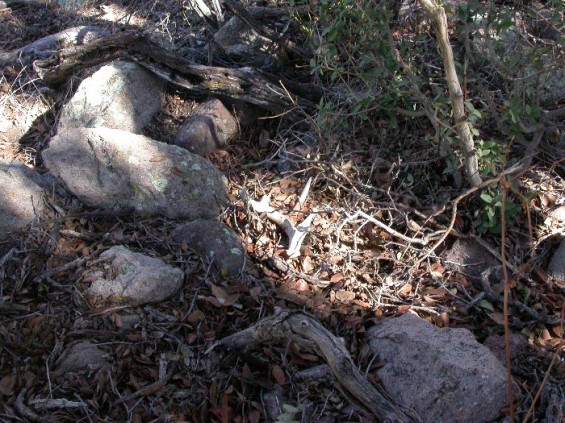
A shed antler I found in the Galiuro Mountains in Arizona during my November 2002 deer hunt. It was lying near some boulders along the side of a dry drainage lined with oak trees. Click on picture to enlarge.
Why Shed Hunt?
Shed hunting can be a great way to scout out an area. While you are searching for antlers, you will learn where the deer trails are and the bedding areas and probably where the water sources are. Shed hunting is also a great way to keep in shape during the off-season. It’s a great family outing too. Kids will enjoy spending time in the woods with you and their eyes will light up if they get lucky enough to find an antler!
When to shed hunt?
Coues deer shed their antlers much later in the year than do the northern and eastern whitetails. Coues shed theirs from April to May. This means that if you are a shed hunter, you will be out hunting up the newest sheds in some of the hottest times of the year. Of course you can find sheds at any time of the year, but the freshest sheds will be in the Spring when the bucks are dropping them. Shed antlers look best when they are newly shed. Over time, the antler becomes cracked and faded if it falls in an area exposed to the sun.
Where to shed hunt?
Did you see a huge buck last fall and you are wondering where his sheds are? Since I am not a big shed hunter, I imagine there are a lot of other people who could answer this question better than I can. Most of the time that I find sheds I am not actively searching for them, but just scouting or hunting. I often find shed antlers in drainages. That is probably due more to the antlers being washed into the drainage rather than the deer actually shedding there. So when I am scouting out an area, I tend to look more for antlers when I am in a drainage. I also find antlers around bedding areas and in some of the more open feeding areas, such as juniper and oak flats. You want to search in areas where the bucks are in April and May. If you are looking for a particular bucks sheds, try and locate where he is spending his time just before shedding time.
Can you train your dog to shed hunt?
Some people do use dogs to help them find sheds. I have a dog who loves to hunt (or rather chase things). But she isn’t very impressed with my request to have her find some inanimate thing like antlers. I have asked around on the best method to train a dog to shed hunt. Some have told me to use the force-breaking-to-retrieve technique. With that technique you are supposed to be able to train a dog to retrieve all kinds of things that it wouldn’t normally be interested in. Other people say they just play games with their dogs involving antlers, so that the dog thinks antlers are fun to pick up.
Have you taught your dog to shed hunt? How did you do it? Let us know.
To see pictures of sheds, go to the Coues deer shed photo gallery.


